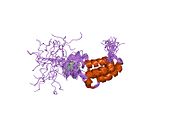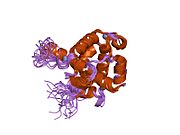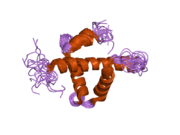EP300
Ensembl | |||||||||
|---|---|---|---|---|---|---|---|---|---|
| UniProt | |||||||||
| RefSeq (mRNA) | |||||||||
| RefSeq (protein) | |||||||||
| Location (UCSC) | Chr 22: 41.09 – 41.18 Mb | Chr 15: 81.47 – 81.54 Mb | |||||||
| PubMed search | [3] | [4] | |||||||
| View/Edit Human | View/Edit Mouse |
Histone acetyltransferase p300 also known as p300 HAT or E1A-associated protein p300 (where E1A = adenovirus early region 1A) also known as EP300 or p300 is an enzyme that, in humans, is encoded by the EP300 gene.[5] It functions as histone acetyltransferase that regulates transcription of genes via chromatin remodeling by allowing histone proteins to wrap DNA less tightly. This enzyme plays an essential role in regulating cell growth and division, prompting cells to mature and assume specialized functions (differentiate), and preventing the growth of cancerous tumors. The p300 protein appears to be critical for normal development before and after birth.
The EP300 gene is located on the long (q) arm of the human
EP300 is closely related to another gene,
Function
p300 HAT functions as histone acetyltransferase[6] that regulates transcription via chromatin remodeling, and is important in the processes of cell proliferation and differentiation. It mediates cAMP-gene regulation by binding specifically to phosphorylated CREB protein.
p300 HAT contains a bromodomain which is involved in IL6 signaling.[7]: 3.1
This gene has also been identified as a co-activator of HIF1A (hypoxia-inducible factor 1 alpha), and, thus, plays a role in the stimulation of hypoxia-induced genes such as VEGF.[8]
Mechanism
The p300 protein carries out its function of activating
Clinical significance
Chromosomal rearrangements involving chromosome 22 have rarely been associated with certain types of cancer. These rearrangements, called translocations, disrupt the region of chromosome 22 that contains the EP300 gene. For example, researchers have found a translocation between chromosomes 8 and 22 in several people with a cancer of blood cells called acute myeloid leukemia (AML). Another translocation, involving chromosomes 11 and 22, has been found in a small number of people who have undergone cancer treatment. This chromosomal change is associated with the development of AML following chemotherapy for other forms of cancer.[citation needed]
Mutations in the EP300 gene have been identified in several other types of cancer. These mutations are somatic, which means they are acquired during a person's lifetime and are present only in certain cells. Somatic mutations in the EP300 gene have been found in a small number of solid tumors, including cancers of the
Interactions
EP300 has been shown to
- BCL3,[10]
- BRCA1,[11][12]
- CDX2,[13]
- CEBPB,[14]
- CITED1,[15]
- CITED2,[16][17][18][19]
- DDX5,[20]
- DTX1,[21]
- EID1,[22][23]
- ELK1,[24]
- ESR1,[11][25][26]
- FEN1,[27]
- GPS2,[28]
- HIF1A,[29][30]
- HNF1A,[31]
- HNRPU,[32]
- ING4,[33]
- ING5,[33]
- IRF2,[34]
- LEF1,[35]
- MAF,[36]
- MAML1,[37][38]
- MEF2C,[39]
- MEF2D,[40][41]
- MYBL2,[42]
- Mdm2,[43]
- MyoD,[39][44]
- MEF2A,[45]
- NCOA6,[46]
- NFATC2,[47]
- NPAS2,[48]
- P53,[43][49][50][51][52]
- PAX6,[13]
- PCNA,[53]
- PROX1,[36]
- PTMA,[54]
- PPARA,[55][56]
- PPARG,[25][57]
- RORA,[44]
- RELA,[58][59]
- SMAD1,[60][61]
- SMAD2,[62][63]
- SMAD7,[64]
- SNIP1,[65]
- SS18,[66]
- STAT3,[61]
- STAT6,[67]
- TAL1,[68]
- TCF3,[69]
- TFAP2A,[17]
- TGS1,[70]
- TRERF1,[71]
- TSG101,[72]
- THRA,[45]
- TWIST1,[73]
- YY1,[74][75] and
- Zif268.[76]
References
- ^ a b c GRCh38: Ensembl release 89: ENSG00000100393 – Ensembl, May 2017
- ^ a b c GRCm38: Ensembl release 89: ENSMUSG00000055024 – Ensembl, May 2017
- ^ "Human PubMed Reference:". National Center for Biotechnology Information, U.S. National Library of Medicine.
- ^ "Mouse PubMed Reference:". National Center for Biotechnology Information, U.S. National Library of Medicine.
- PMID 7523245.
- PMID 8945521.
- PMID 26472704.
- ^ "Entrez Gene: EP300".
- PMID 17467953.
- PMID 10497212.
- ^ PMID 11782371.
- PMID 10655477.
- ^ PMID 10506141.
- PMID 9343424.
- PMID 10722728.
- PMID 9887100.
- ^ PMID 12586840.
- PMID 11744733.
- PMID 10593900.
- PMID 12527917.
- PMID 11564735.
- PMID 11073989.
- PMID 11073990.
- PMID 12514134.
- ^ PMID 12479814.
- PMID 11867769.
- PMID 11430825.
- PMID 10846067.
- S2CID 24045310.
- PMID 11959990.
- PMID 11978637.
- PMID 11909954.
- ^ PMID 12750254.
- PMID 11304541.
- PMID 12446687.
- ^ PMID 11943779.
- PMID 12391150.
- PMID 12050117.
- ^ PMID 9001254.
- PMID 10825153.
- PMID 10933397.
- PMID 11733503.
- ^ PMID 9809062.
- ^ PMID 9862959.
- ^ PMID 12371907.
- PMID 10823961.
- PMID 9625762.
- PMID 14645221.
- S2CID 14375605.
- PMID 15186775.
- PMID 10942770.
- PMID 11782467.
- S2CID 2129847.
- PMID 11967287.
- PMID 9407140.
- PMID 10336495.
- PMID 10944516.
- PMID 12419806.
- PMID 9096323.
- PMID 10673036.
- ^ PMID 10205054.
- PMID 10199400.
- PMID 11371641.
- PMID 12408818.
- PMID 10887155.
- PMID 11030627.
- PMID 10454341.
- PMID 10490830.
- PMID 12435739.
- PMID 11912212.
- PMID 11349124.
- S2CID 26971556.
- PMID 10025406.
- PMID 11486036.
- PMID 7758944.
- PMID 9806899.
Further reading
- Condorelli G, Giordano A (1998). "Synergistic role of E1A-binding proteins and tissue-specific transcription factors in differentiation". J. Cell. Biochem. 67 (4): 423–31. S2CID 22772125.
- Marcello A, Zoppé M, Giacca M (2002). "Multiple modes of transcriptional regulation by the HIV-1 Tat transactivator". IUBMB Life. 51 (3): 175–81. S2CID 10931640.
- Kino T, Pavlakis GN (2004). "Partner molecules of accessory protein Vpr of the human immunodeficiency virus type 1". DNA Cell Biol. 23 (4): 193–205. PMID 15142377.
- Ott M, Dorr A, Hetzer-Egger C, Kaehlcke K, Schnolzer M, Henklein P, Cole P, Zhou MM, Verdin E (2004). "Tat acetylation: a regulatory switch between early and late phases in HIV transcription elongation". Reversible Protein Acetylation. Novartis Foundation Symposia. Vol. 259. pp. 182–93, discussion 193–6, 223–5. PMID 15171254.
- Le Rouzic E, Benichou S (2006). "The Vpr protein from HIV-1: distinct roles along the viral life cycle". Retrovirology. 2: 11. PMID 15725353.
External links
- GeneReviews/NCBI/NIH/UW entry on Rubinstein-Taybi Syndrome
- GeneCard
- EP300+protein,+human at the U.S. National Library of Medicine Medical Subject Headings (MeSH)
- NURSA C54
- FactorBook P300
This article incorporates text from the United States National Library of Medicine, which is in the public domain.









